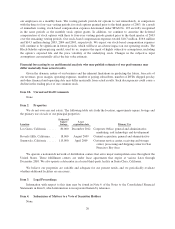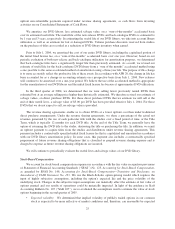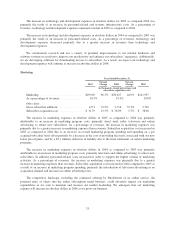NetFlix 2005 Annual Report Download - page 40
Download and view the complete annual report
Please find page 40 of the 2005 NetFlix annual report below. You can navigate through the pages in the report by either clicking on the pages listed below, or by using the keyword search tool below to find specific information within the annual report.Recent Developments and Initiatives
We continue to face direct competition from Blockbuster. It remains possible that other potential entrants
will offer competing services, either directly or in conjunction with others or that Blockbuster will gain more
traction in its current business. We continue to focus on retaining our leadership position and growing our
business.
We launched two new revenue initiatives in 2005: retail sales of previously-viewed DVDs and our Ad Sales
program. We also continue to invest resources to develop solutions for downloading movies to consumers. Our
core strategy has been and remains to grow a large DVD subscription business. However, as technology and
infrastructure develop to allow effective and convenient delivery of movies over the Internet and when
meaningful content becomes available, we intend to offer our subscribers the choice of receiving their movies on
DVD or by downloading, whichever they prefer.
Key Business Metrics
Management periodically reviews certain key business metrics, within the context of our articulated
performance goals, in order to evaluate the effectiveness of our operational strategies, allocate resources and
maximize the financial performance of our business. The key business metrics include the following:
•Churn: Churn is a monthly measure defined as customer cancellations in the quarter divided by the
sum of beginning subscribers and gross subscriber additions, then divided by three months.
Management reviews this metric to evaluate whether we are retaining our existing subscribers in
accordance with our business plans.
•Subscriber Acquisition Cost: Subscriber acquisition cost is defined as total marketing expense divided
by total gross subscriber additions. Management reviews this metric to evaluate how effective our
marketing programs are in acquiring new subscribers on an economical basis in the context of estimated
subscriber lifetime value.
•Gross Margin: Management reviews gross margin to monitor variable costs and operating efficiency.
Management believes it is useful to monitor these metrics together and not individually as it does not make
business decisions based upon any single metric.
Critical Accounting Policies and Estimates
The preparation of consolidated financial statements in conformity with accounting principles generally
accepted in the United States requires estimates and assumptions that affect the reported amounts of assets and
liabilities, revenues and expenses and related disclosures of contingent assets and liabilities in our consolidated
financial statements and accompanying notes. The Securities and Exchange Commission has defined a
company’s critical accounting policies as the ones that are most important to the portrayal of a company’s
financial condition and results of operations, and which require a company to make its most difficult and
subjective judgments. Based on this definition, we have identified the critical accounting policies and judgments
addressed below. Although we believe that our estimates, assumptions and judgments are reasonable, they are
based upon information presently available. Actual results may differ significantly from these estimates under
different assumptions, judgments or conditions.
Amortization of DVD Library and Upfront Costs
We acquire DVDs from studios and distributors through either direct purchases or revenue sharing
agreements. We acquire DVDs for the purpose of renting them to our subscribers and earning subscription rental
revenues and as such, we consider our DVD library to be a productive asset, and classify our DVD Library as a
non-current asset. Additionally, in accordance with Statement of Financial Accounting Standards 95 “Statement
of Cash Flows” (“SFAS 95”), we classify cash outflows for the acquisition of the DVD Library, including any
24
























